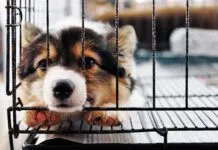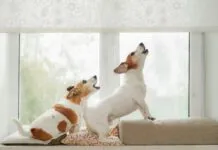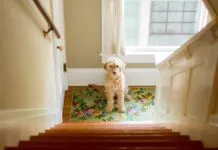The other day, a client reached out because her new puppy was a nightmare whenever the family sat down to dinner. The first few nights, he was jumping up, grabbing napkins, and sinking sharp puppy teeth into the nearest human appendage. After that, they tried crating him, but he barked, nonstop, at the top of his lungs.
The owner was at her wit’s end—a common place to be during puppyhood—saying, “We need to be able to eat in peace!” She had read that she should teach the puppy “place” so that he’d calmly lie on his bed during dinner hour.
That is a lovely vision, indeed, but it’s a very high bar for a 9-week-old puppy. There’s a more realistic way to create a peaceful kitchen table scene for the humans that works beautifully for your puppy, too.
Why Is he Acting This Way?
First, let’s think about this from the puppy’s point of view. (That is, of course, the smartest kick-off to solving any dog issue. If you want your answers to be long lasting, they have to work for the canine partner, too.)
So, why is the puppy being so annoying during the family dinner? First off, his nose is basically screaming at him: “OMG, there’s food!” A dog has more than 200 million scent receptors in his nose compared to our measly six million. If dinner smells good to you, just imagine what it smells like to him!
Combine that with the deeply rooted survival instincts that tell him to grab nutrition whenever he can, and of course he’s going to make a beeline for your plate.
If that weren’t enough, consider another motivating factor: togetherness. This little puppy only recently left his real family, where he spent every waking hour surrounded by littermates and mom. He’s not used to being alone, and wow does it feel terrific when this whole new family is all together, particularly if they were off at work and school all day.
So, to recap, this little pup is very naturally over-aroused because of the excitement of the food and the thrill of the togetherness. Now that we think about it, we humans can’t get cranky about that, right? As the adults in the room, we just need to help our little toddler navigate this moment in a way that works for us all.
Planning Ahead to Meet your Puppy’s Needs
Since we can expect a pup to have big feelings around our human dinner hour, that means we’re able to make a plan ahead of time. What can we do? How can we structure this regular occurrence to bring out the best in the pup and teach him the behavior we’d like to see? Try putting this three-step plan into action at mealtimes:
- Address the food issue with a frozen Toppl. Rather than keeping the pup on a different eating schedule, give the puppy his dinner at the same time you sit down at the table, so that he’s busy enjoying his own delicious meal instead of lusting after yours.
If you’re thinking, “But it only takes him 20 seconds to snarf up that scoop of kibble,” you’re right! That’s why you’ll want to freeze his dinner to make it last.
Take that same scoop of kibble, add some water and a spoonful of plain yogurt to make a slurry. If you’re inspired, add a dollop of peanut butter or canned pumpkin. Even more inspired? Add a few veggies like carrots and beans.
Use that concoction to stuff a few Toppls, and then freeze them. (Toppls, a chew-resistant toy made by West Paw, have a wider opening than Kongs, so the pup is more likely to enjoy them to the very last drop.)
If you’re thinking it feels a little mean to make food harder to eat, remember that it is natural for a canine to forage for his food. In fact, this session of chewing and licking will be deeply satisfying for your puppy. Studies have shown that for dogs, chewing and licking can be calming, lowering heart rates and reducing anxiety.
- Address the togetherness issue with a nearby crate. Rather than isolating the puppy elsewhere during this rewarding moment of family togetherness, make a plan to help him be a part of it.
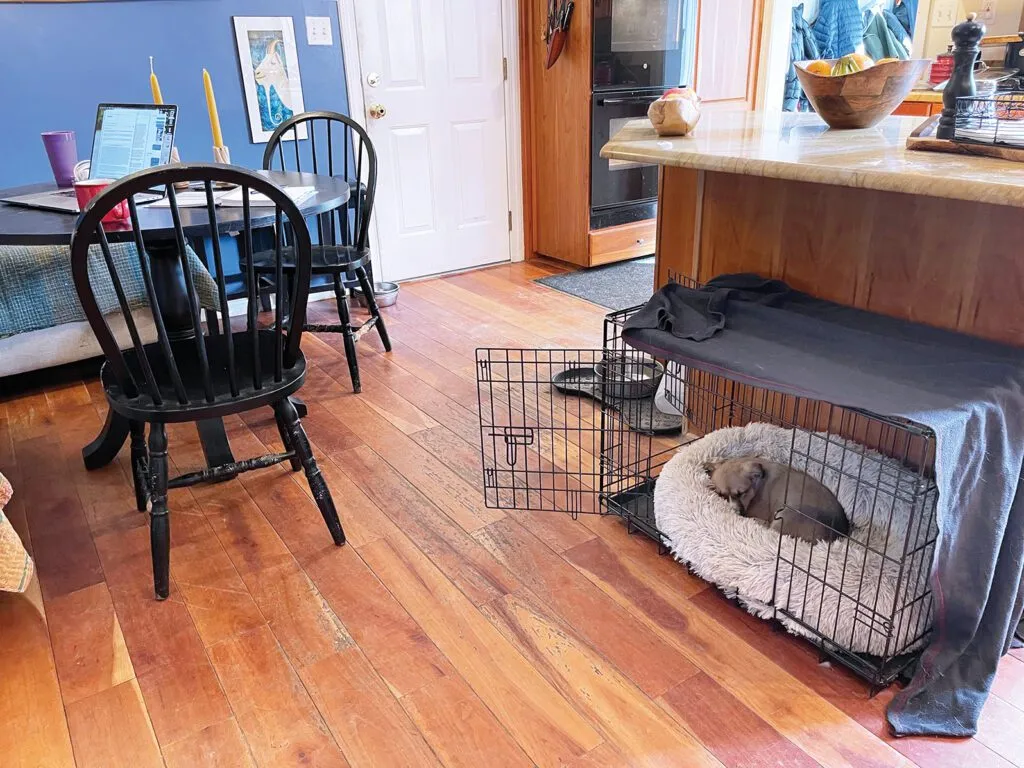
My favorite way to structure this is to have the puppy’s crate in the kitchen, so that he can enjoy his Toppl while being included in the family dinner. He can listen to his people, smell and see everything — but you’re helping him develop the habit of lying quietly nearby during mealtimes. Keeping him confined but happily busy keeps him from practicing unwanted habits like jumping, biting, barking, and whining.
- Address the engagement issue with timing. If the Toppl and crate don’t work well immediately at your house, think about what happens for the hour before dinner. Has the pup had a chance to engage with everybody in the room? If they just walked in the door after being away, it may be hard for the puppy to settle.
Try adjusting your timing a bit. Build in a high-engagement 15-minute game in the yard or the rec room to give your pup a chance to connect the way he needs to, before asking him to sit quietly just feet from his favorite people without touching them.
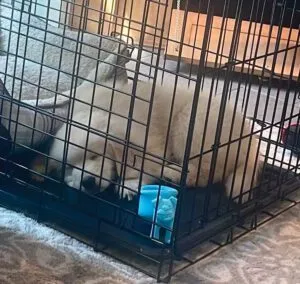
Credit: Kathy Callahan
Over time, all of this becomes a deeply ingrained pattern, and trust me when I say that patterns can be the unsung heroes of a relaxed interspecies life. When something simply becomes “how we do it,” there’s no need for a bunch of cues and direction. In this case, the pup starts to look forward to your dinner hour as the time he gets to run to his crate and enjoy chewing and listening.
If you still want to work toward using “place” during dinner, this is a wonderful first step. You are teaching how to hang out quietly nearby the family while they’re eating. Next you can start separately teaching how to go to “place” for a few seconds, then for a minute. As you strengthen those behaviors over time, one day you can marry them in that beautiful “place” on the bed during dinner. But for now, with your little one? The well-timed Toppl-and-crate combination will do the trick.





